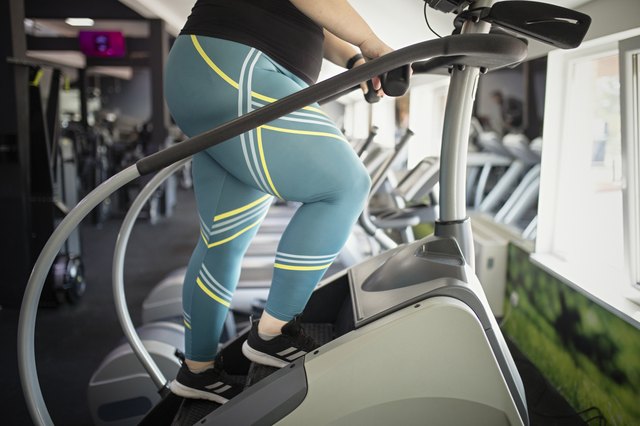
Get your heart rate up and work your whole body with this stair workout.
Image Credit:
M_a_y_a/E+/GettyImages
You’ve probably heard the suggestion of taking stairs instead of escalators and elevators to help you reach your step goals, and it’s a great way to increase your daily movement. But the steps are also a great addition to your gym routine.
The stair stepper provides a great workout for your quads and entire posterior chain (glutes, hamstrings, calves, lats, rhomboids, and spinal erectors), but you might be surprised to learn that it engages also your core and upper body.
When using the stair step, stand up straight instead of slouching on the handrails or standing and leaning back (this is especially easy to do when you’re tired). Squeeze your shoulder blades lightly to help you stand up and engage your upper back muscles as well.
If you hold on to the railings, you will engage your upper body, but you have to be careful not to over-tighten. There should be only minimal tension in the hands. The tension in the body takes the energy needed for the steps.
If you choose not to hold on to the railings, keep your arms at a 90 degree angle and push your elbows back to help you climb the stairs – this will also help you keep your balance. To further engage the core, with each step you take, consider lifting your leg off your abdomen, verses leading with your quad muscle.
Advice
If you choose not to hold on to the railing, be sure to lean forward a bit from the hips to help keep your balance and activate your hamstrings.
This 20-minute stair routine consists of intervals starting strong, then decreasing the time in higher heart rate zones with active recovery. In the second half, you’ll go up to longer times in higher heart rate zones with active recovery. At the very end you will have a short burst of maximum effort before full recovery.
Choose a pumping playlist and get ready for a fast and challenging climb to the top!
Advice
Use your Rating of Perceived Exertion (RPE) to help determine which levels you should be using. RPE operates on a scale of 1 to 10 and helps you determine how difficult an activity is. The higher the number, the more difficult the exercise.
In this workout, we’re asking you to achieve RPEs of 3, 5, 7, and 8-10. Here’s how you should feel:
- PRE 3: Can easily hold a conversation. You work, but not too hard.
- PRE 5: Noticeably difficult, but doable. You could hold a conversation, but it would be difficult.
- PRE 7:very difficult. You couldn’t say more than two or three words out of breath.
- PRE 8 to 10:out of breath. Don’t talk at all!
20 minute stair workout
|
Level |
PRE |
Time |
|---|---|---|
|
Start at an RPE level of 3 (about level 4) |
3 |
1 minute |
|
Increase level by 3 |
5 |
4 minutes |
|
Level up 4 to 6 more |
7 |
90 seconds |
|
Decrease level by 2 |
5 |
1 minute |
|
Increase level from 3 to 4 |
7 |
1 minute |
|
Decrease level from 3 to 4 |
5 |
1 minute |
|
Increase level from 3 to 4 |
7 |
45 seconds |
|
Decrease level from 3 to 4 |
5 |
1 minute |
|
Increase level from 3 to 4 |
7 |
45 seconds |
|
Decrease level from 3 to 4 |
5 |
1 minute |
|
Increase level from 3 to 4 |
7 |
1 minute |
|
Decrease level from 3 to 4 |
5 |
1 minute |
|
Increase level from 3 to 4 |
7 |
90 seconds |
|
Decrease level from 3 to 4 |
5 |
1 minute |
|
Increase level from 5 to 6 |
8 to 10 |
30 seconds |
|
Decrease level to beginner level |
3 |
2 minutes |
Sources):
Brittany Hammond
